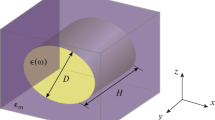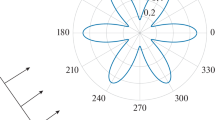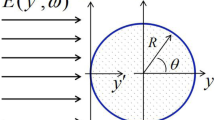Abstract
Numerical simulation of localized plasmon resonances for an elliptical gold nanodisk 300 × 400 nm in size and 20 nm in thickness with two cylindrical holes 140 nm in diameter is carried out. Plasmon modes excited by light with longitudinal and transverse polarization are studied. The sensitivity of the dipole mode wavelength to changes in the dielectric constant of the medium is higher with longitudinal polarization and reaches values of the order of 1800 nm/RIU.
Similar content being viewed by others
Avoid common mistakes on your manuscript.
Nanoparticles of noble metals have unique optical properties; therefore, materials based on them can be used in various fields of science and technology: from optical instruments and microelectronics to photocatalysts, biomedical applications, and biosensors. These properties are due to the possibility of excitation of localized surface plasmon resonance (SPR), that is, collective electron density oscillations at the metal–dielectric interface, accompanied by the absorption and scattering of light of a certain wavelength [1, 2].
Currently, the majority of industrial optical biosensors based on the phenomenon of surface plasmon resonance use a thin layer of gold deposited on a glass surface [3]. At a certain angle of incidence and the wavelength of the irradiating light, the electron density waves (plasmon polaritons) propagating along the film surface can occur in such a system. When the dielectric constant of the medium changes near the gold surface as a result of adsorption of biomolecules, the resonance conditions change. The resonant frequency of the excitation light at a fixed angle of incidence of the beam, the resonant angle of incidence of the beam at a fixed frequency, or the amplitude or phase of the light can be the recorded parameters. The first two types of SPR detection are called spectroscopy of surface plasmons with frequency and angular spectra, respectively [3].
In recent years, sensing nanoscale systems based on nanoparticles of noble metals have been actively developed. In contrast to solid metal layers, a localized plasmon resonance (LSPR), that is, charge oscillations bounded by the surface of the nanoparticle, is excited in these systems under the action of light. The sensitivity of the LSPR to a local change in the dielectric constant is determined by the magnitude of the electric field caused by the oscillations of the electron density and the degree of its localization near the metal surface. In order to optimize these parameters, nanoparticles of various shapes, including nanorods, nanobipyramids, and nanorings, are widely studied [4].
The sensitivity of the LSPR of gold nanoparticles of different shapes is compared in Table 1. The sensitivity of the LSPR of spherical and cubic nanoparticles is lower than that of nanoparticles in the form of rings or bipyramids. The LSPR of nanoparticles of different shapes and sizes vary. When comparing gold nanoparticles in the form of a sphere, cube, block, rod, and bipyramid, the most unsatisfactory results of LSPR detection were obtained for nanospheres and nanocubes. The best indicators are obtained for nanoparticles in the form of rings [4].
In the present work, the sensitivity of a localized surface plasmon resonance in gold nanoparticles with the shape of an elliptical disk with two holes is theoretically studied.
NUMERICAL EXPERIMENTS
A theoretical simulation of the transmission spectra of nanoparticles in the form of a disk with two holes was carried out using the FDTD Solutions (Lumerical) program [5] by the finite-difference time-domain method. The simulated system was an elliptical disk (h = 20 nm, D1 = 300 nm, D2 = 400 nm) with two cylindrical holes with a diameter of d = 140 nm (Fig. 1).
For gold, an approximate dielectric function was used, developed based on the experimental data [6]; for the rest of the region, a constant refractive index was used. In the field of nanoparticles, a mesh with a spatial resolution of 2 nm was used. To limit the size of the simulated system, perfectly matched layers (PML) were used as the boundary conditions. The transmission spectra were obtained by determining the amount of energy passing through the surface of a given area after interacting with the structure.
RESULTS AND DISCUSSION
Figures 2 and 3 show the calculated transmission spectra of the studied nanoparticles for the longitudinal and transverse polarization of the excitation electromagnetic wave. The spectra show three main peaks corresponding to three plasmon modes. The electric field distributions of E/E0 near the particle for modes (1), (2), and (3) are also given in Figs. 2 and 3. The most intense band (3) in the spectra corresponds to the long-wavelength plasmon mode, which has a dipole nature. A major field enhancement is observed near the outer boundary of the nanoparticle and reaches 19 for the longitudinal and 15 for the transverse polarization of the excitation wave. The shorter-wavelength bands in the spectra correspond to hybridized plasmon modes of cylindrical holes with higher order nanodisk modes.
To assess the sensitivity of nanoparticles of this form, we simulated the shifts of the spectral bands depending on the refractive index of the medium in the range of 1.33–1.48. The results for longitudinal and transverse polarization are presented in Fig. 4.
At different refractive indices, theoretical sensitivity values were calculated depending on the wavelength shift.
For longitudinal polarization, we have
For transverse polarization, we obtain
The obtained sensitivity values exceed the sensitivity of previously studied nanostructures of other shapes (Table 1), which indicates the promise of their use for biosensor applications. In our further work, we plan to study the effect of the size and position of the holes in the disk on its optical properties and to obtain and study nanoparticles of this shape experimentally.
CONCLUSIONS
The simulation results show that when a localized surface plasmon resonance is excited in nanoparticles shaped as a 300 × 400 nm nanodisk with a with two holes 140 nm in diameter, the regions with a high local field are observed. Localization of the regions can be controlled by changing the polarization and wavelength. Based on the theoretical calculations of sensitivity, it can be argued that plasmon nanodisks with two holes are more useful for biosensor applications than nanoparticles of other geometric shapes (1808 nm/RIU and 1091 nm/RIU).
REFERENCES
Goettmann, F., Daniel, M.C., and Quinn, B.M., New J. Chem., 2006, vol. 30, no. 8, p. 1121.
Martin, C.R., Science, 1994, vol. 266, p. 1961.
Surface Plasmon Resonance Based Sensors, Homola, J., Ed., Heidelberg: Springer, 2006.
Chen, H., Kou, X., Yang, Z., Ni, W., and Wang, J., Langmuir, 2008, vol. 24, p. 5233.
Lumerical. http://www.lumerical.com/tcad-products/fdtd/.
Johnson, P.B. and Christy, R.W., Phys. Rev. B: Solid State, 1972, vol. 6, no. 12, p. 4370.
Funding
This work was supported by the Russian Foundation for Basic Research, project no. 18-03-00730.
Author information
Authors and Affiliations
Corresponding author
Ethics declarations
The authors declare that they have no conflict of interest.
Additional information
Translated by O. Zhukova
About this article
Cite this article
Aferenok, A.S., Shabatina, T.I. & Bochenkov, V.E. Simulation of the Optical Properties of Gold Nanodisks with Two Holes. Moscow Univ. Chem. Bull. 74, 232–235 (2019). https://doi.org/10.3103/S002713141905002X
Received:
Revised:
Accepted:
Published:
Issue Date:
DOI: https://doi.org/10.3103/S002713141905002X








